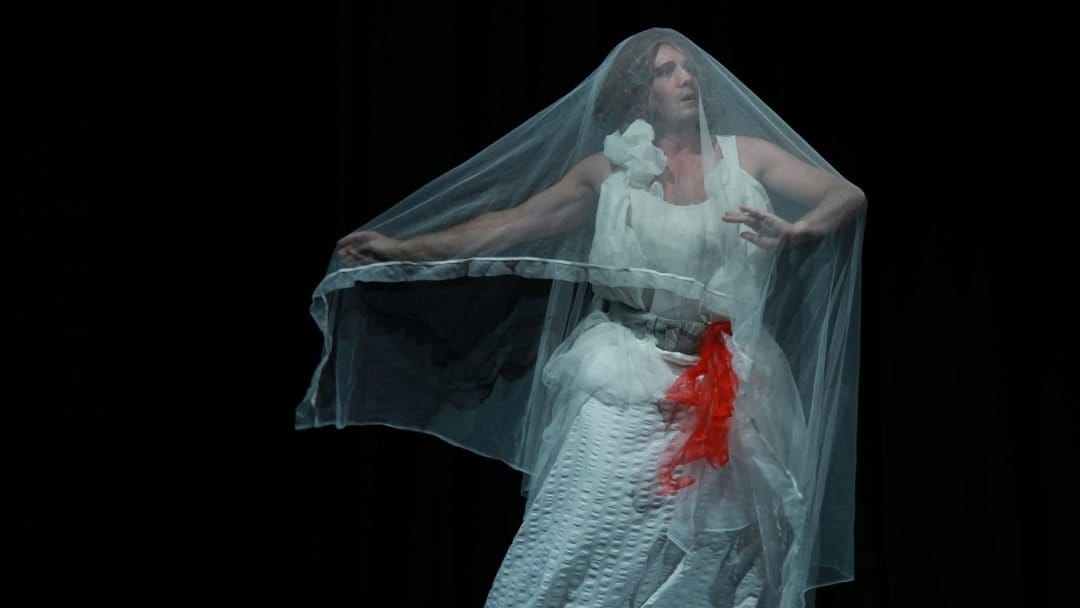Daniel Somerville is a performance maker and educator. He trained at Royal Central School of Speech and Drama, and at Goldsmiths, University of London. His PhD is from University of Wolverhampton. He has presented work nationally and internationally.
No stranger to the Edinburgh Festival Fringe, in 2008 he was in Rose Lewenstein’s Strippers and Gentlemen, and performed his queer cabaret Mermaid act as part of the show’s late-night edition. In 2010 he appeared in Scottee’s Eat Your Heart Out performing Oh! England, his signature queer critique of English nationalism.
In the same year, but at Brighton Fringe, he presented a triple bill of Butoh dances called Three Works to critical acclaim. In 2012-13, supported by Arts Council England, he created three dances called Episodes. He is currently a Senior Lecturer in Drama and Performance at University of Worcester where his research interests concern opera, the operatic, contemporary and queer performance.
Admiring La Stupenda is at Greenside @ Nicolson Square (Emerald Theatre) 2nd – 17th August (not 11th) at 3pm.
Admiring La Stupenda is coming to Greenside @ Nicolson Square what can you tell us about it?
On one level it’s a middle-aged opera queen talking about his favourite singer and dressing up in improvised opera gowns and talking about his mum. On another level it’s a performance-lecture on operatic-ness that tilts into a physical theatre performance on the devastating effects of anxiety. It’s a performance in which I relay anecdotes about opera, as well as autobiographical anecdotes, and I move.
I dance in a style informed by Butoh – a Japanese contemporary dance practice. It’s a playful homage to one of Butoh’s iconic performances, Admiring L’Argentina. So, it’s funny and sad in places, playful and emotional. It’s interesting for theatre audiences, dance goers and opera lovers. But you absolutely don’t have to know anything about opera, or even like opera to enjoy it. There are lots of layers – it depends how you want to engage with it.
How does this production differ to other works you’ve written?
The work I have made before is either short-form queer cabaret or mid-length pure movement works – so having all this text to remember is very new for me. I have spoken in some performances before and people seemed to like it so this time I’m just going for it – telling stories, direct address to the audience. I’m not a character – it’s me on stage being me, talking about what I love. So, it’s authentic. Anyone familiar with my work will recognise trademark features; playing with bits of material, dressing up, transformation, operatic-ness and camp… bubbles maybe!
How does it feel to be at Greenside @ Nicolson Square?
It feels great. Greenside @ Nicolson Square have been very supportive and welcoming. The space itself is exciting. The work was conceived as an end on production but I’m having to rework it for a thrust stage. The Emerald Theatre is in the Methodist Church, so it has some of the grandeur I like – but I chose it mostly because even though I am alone on stage, I like a lot of room, and the stage is sizeable. Also, my mother’s mother was a Methodist so it’s lovely to be performing in that environment – I feel a connection.
How did you research the subject of Admiring La Stupenda?
I did a lot of reading about opera and about movement and acting in opera, and I spent countless hours watching opera singers in rehearsal and in performance. Making notes, sketching them, interviewing them. And then taking what I’d observed and finding ways to embody it using techniques from Butoh. Then once I had a corporeal understanding of the movement, I started focussing on my favourite singer – La Stupenda (Joan Sutherland), watching videos and observing her particular way of performing. I’m not copying her though or simply lip-synching – it’s more like I’m embodying the memory of her.
Who will Admiring La Stupenda appeal to the most?
When I have previewed it in academic venues lots of students have been very complimentary – I suppose it’s partly about seeing an older performer (and a lecturer) letting his hair down. It appeals to a contemporary queer audience because it gives some insight into a bygone identity – the opera queen. For that reason, I suppose it will also appeal to older gay men. Peers who have seen and who are not into opera have said it doesn’t matter – there’s so much more to it than the opera. But obviously it will appeal greatly to anyone who likes opera.
What’s the one thing about Admiring La Stupenda that makes it different from all the rest?
I’d say what makes Admiring La Stupenda different from other shows is maybe the way it was made, and how long that took. It was created as a chapter of my PhD – it’s a practice research output in fact. Which means that I spent years studying the movement of opera singers and creating a choreographic vocabulary in order to come up with a practice that is informed by Butoh, queer performance and my love of opera. But if that sounds dry… well it’s not, it’s actually quite camp and very accessible. I’m a storyteller. I bring ideas together as I talk and move, and the audience get to feel something, understand something by the end. It slips between the gaps – not quite dance, not quite performance lecture, not quite theatre – but actually all of those things. It is both nostalgic and highly contemporary.















